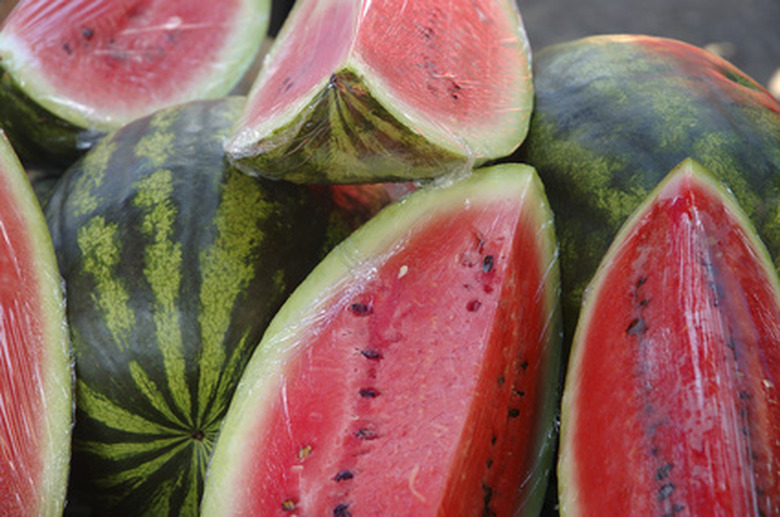How To Grow Watermelons In Houston, Texas
According to the Watermelon.org, the United States ranks fourth in production of watermelons. Out of the 44 states that produce watermelons, Texas is one of only five states that consistently leads watermelon production in the U.S. There are four categories of watermelons: picnic, icebox, seedless and yellow flesh. No matter the variety you choose to grow — in Texas everything is said to be bigger and better — so your venture is sure to be a success.
Step 1
Plant watermelon seeds at the last sign of winter; when there is no more chance of frost. Spring temperatures in Houston are the perfect growing weather for the watermelon plant, and the fruit that follows. Sow the seeds one inch deep with four to six seeds in a mound. Space the mounds six feet apart.
- According to the Watermelon.org, the United States ranks fourth in production of watermelons.
- Out of the 44 states that produce watermelons, Texas is one of only five states that consistently leads watermelon production in the U.S.
- There are four categories of watermelons: picnic, icebox, seedless and yellow flesh.
Step 2
Water the plants regularly. Watermelons are 95 percent water; so they need watering more than most other plants. Avoid watering plants overhead, as that can result in mildew. Side dress the melons with compost or manure tea every two or three weeks.
Step 3
Pinch out a plant, if one is growing early. You want to encourage the watermelon to set three or four fruits at a time. If a single plant is growing, it will suppress the other fruit.
- Water the plants regularly.
- You want to encourage the watermelon to set three or four fruits at a time.
Step 4
Watch for aphids and cucumber beetles. Cucumber beetles transmit cucumber bacterial wilt. This will kill the plant, even before it bears fruit. Aphids can be hosed off the melons: While cucumber beetles will need to be hand-picked and destroyed.
Step 5
Stop watering the melons a week before harvesting. The melons should be ready 65 to 90 days after sowing. The vine tendrils will turn brown and die off, showing you that the melon is ripe. You will also be able to hear a dull sound when you thump it.
- Watch for aphids and cucumber beetles.
- This will kill the plant, even before it bears fruit.
Pick Watermelons
As watermelons grow and mature, their colors change, indicating when they are ripe for the picking. On a ripe watermelon, the color of its stripes indicate maturity; if the stripes have a noticeable contrast, the fruit is probably ready for harvest. The underside of a watermelon also tells a lot about whether it's done growing. A watermelon should respond to the proper touch in a couple of key ways when ripe. If the melon is ripe, this area will be firm and difficult to dent by pressing a fingernail into it. The rest of the melon's vines will still be alive. If the pigtail is almost dead, the fruit is on the cusp of ripeness. Watermelons require careful handling to avoid internal bruising and should be stored at a temperature between 60 and 70 degrees Fahrenheit. Significant exposure to temps outside of this range will cause the fruit to deteriorate and spoil.
- As watermelons grow and mature, their colors change, indicating when they are ripe for the picking.
- On a ripe watermelon, the color of its stripes indicate maturity; if the stripes have a noticeable contrast, the fruit is probably ready for harvest.
References
- Vacations Made Easy: Houston, Texas Weather Information
- Harvest Wizard: How to Grow Watermelon
- Gardening Channel: How to Grow Watermelon
- The Old Farmer's Almanac: Watermelons
- New Mexico State University: Picking Ripe Watermelons
- University of Illinois: Watermelon
- University of California Davis: Watermelon: Recommendations for Maintaining Postharvest Quality
